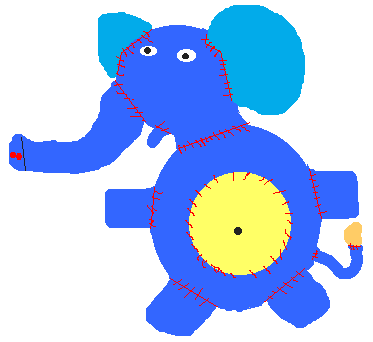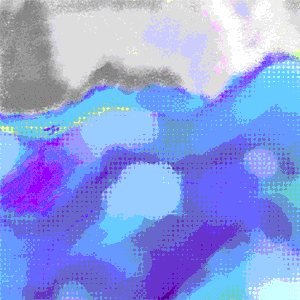By Alison King, Technology Curriculum Consultant
|
Welcome NAEA members!
You've come to the right place! |
|
| Learning to Look at Digital Paint | |
| Applying What We Know About Magnification | |
| Think Like Monet by Painting with Light NEW! | |
| Introduction to Paint Manipulation in Photoshop | |
| Introduction to Digital Photography | |
| Introduction to Photo Manipulation | |
| Intermediate Photo Manipulation | |
| Advanced Photo Manipulation Samples | |
| Intermediate 3D Modeling with Bryce NEW! | |
| Animation Techniques in HyperStudio | |
| Traditional Cel Animation Techniques in HyperStudio | |
| Using the Scanner to Transform Textures for Digital Painting | |
| A Research Project on Copyright Law and the Digital Arts | |
|
.
|
|
"Heffalump" art © 1998 Stephen F.
NEW! Favorite Digital Art Education Resources on the WWW What is Demonstration Dialogue, and why should I try using it? Ways Language and Dialogue Can Help Foster Creativity With Technology Questions teachers can ask students to help them reflect upon, respond to and revisit their digital artworks Group Share techniques Literature Review of Contemporary Theory and Practice in Digital Art Education New York State Standards that support the Digital Arts Bibliography of Multimedia Art Education |
| The Sketchstacks Curriculum
I have long been interested in the relationship between the development of "standalone" digital artworks intended to be viewed in isolation from others and the creation of hypertextual documents intended to show a body of work. In the creation of standalone artworks, there is often a sequencing of thought from initial development to completion, and the atist's ability to make revisions to a work-in-progress is a powerful stimulus to experiment with alternate solutions. This sequence is often recorded by the artist's collection of works-in-progress: self portrait version 1.0, for example, may branch and develop into three distinct self portraits with vastly different results. Still Life with Mango by Tyler Evans, Grade 6
One advantage to keeping a sketchstack is to allow a number of multimedia projects to be easily accessed through a single computer application. Whether Photoshop, Painter, Dabbler, HyperStudio, Avid Cinema, or GIFBuilder software was used to create the artwork, all of these media can be viewed through a single sketchstack. The stack allows the student easy access to all of her projects in one central location, and by virtue of their high visibility, the student is more likely to revisit past artworks and improve upon them as she grows in competence and creativity. The Sketchstacks Curriculum is copyright Alison King 1998 & 1999. Portions of the curriculum are presented in modified form on this website for educational, not-for-profit and personal use only. A copy of the full curriculum may be ordered electronically by contacting the author. The SketchStacks Curriculum was developed under the generous advisement and supervision of Professor Prabha Sahasrabudhe at Teachers College, Columbia Univeristy, New York City. - m o r e -
©1997-2001 Alison King All artwork contained herein is used with the expressed permission of the artists. |
did you come in through the back door?
 Supporting documents for this curriculum include:
Supporting documents for this curriculum include:  Any good digital art educator will encourage this kind of sequencing (or seriation), thereby allowing the student to take as many playful risks as needed to develop an artwork to its fullest potential. The sequential art creation patterns students develop when creating standalone digital artworks can easily be documented in a sketchstack. The "story" of an artwork's creation can be told from beginning to end in a sketchstack, like unpeeling the layers of an onion to its core. While this can be done on the simplest level by studying a student's folder full of artwork one-by-one, the presentation of the same body of work in a hypermedia context allows the student to select pivotal points in the creative process, to sequence them in a personally meaningful order, and to self-select the most seminal works in a series.
Any good digital art educator will encourage this kind of sequencing (or seriation), thereby allowing the student to take as many playful risks as needed to develop an artwork to its fullest potential. The sequential art creation patterns students develop when creating standalone digital artworks can easily be documented in a sketchstack. The "story" of an artwork's creation can be told from beginning to end in a sketchstack, like unpeeling the layers of an onion to its core. While this can be done on the simplest level by studying a student's folder full of artwork one-by-one, the presentation of the same body of work in a hypermedia context allows the student to select pivotal points in the creative process, to sequence them in a personally meaningful order, and to self-select the most seminal works in a series.